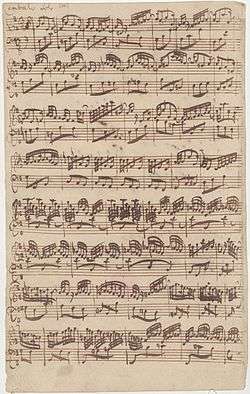Partitas for keyboard (Bach)

The Partitas, BWV 825–830, are a set of six harpsichord suites written by Johann Sebastian Bach, published from 1726 to 1730 as Clavier-Übung I, and the first of his works to be published under his direction. They were, however, among the last of his keyboard suites to be composed, the others being the six English Suites, BWV 806-811 and the six French Suites, BWV 812-817.
History


The six partitas for keyboard are the last set of suites that Bach composed and the most technically demanding of the three. They were composed between 1725 and 1730 or 1731. As with the French and English Suites, the autograph manuscript of the Partitas is no longer extant.
In keeping with a nineteenth-century naming tradition that labelled Bach's first set of Suites English and the second French, the Partitas are sometimes referred to as the German Suites.[1] This title, however, is a publishing convenience; there is nothing particularly German about the Partitas. In comparison with the two earlier sets of suites, the Partitas are by far the most free-ranging in terms of structure. Unlike the English Suites, for example, wherein each opens with a strict prelude, the Partitas feature a number of different opening styles including an ornamental Overture and a Toccata.
Although each of the Partitas was published separately under the name Clavier-Übung (Keyboard Practice), they were subsequently collected into a single volume in 1731, with the same name, which Bach himself chose to label his Opus 1.[2] Unlike the earlier sets of suites, Bach originally intended to publish seven Partitas, advertising in the Spring of 1730 upon the publication of the fifth Partita that the promised collected volume would contain two more such pieces. The plan was then revised to include a total of eight works: six Partitas in Part I (1731) and two larger works in Part II (1735).
The keys of the six Partitas (B-flat major, C minor, A minor, D major, G major, E minor) seem to be an irregular sequence, but in fact they form a sequence of intervals going up and then down by increasing amounts: a second up (B-flat to C), a third down (C to A), a fourth up (A to D), a fifth down (D to G), and finally a sixth up (G to E).[3] The key sequence continues into Clavier-Übung II (1735) with two larger works: the Italian Concerto, a seventh down (E to F), and the French Overture, an augmented fourth up (F to B-natural). Thus this sequence of customary tonalities for 18th-century keyboard compositions is complete, extending from the first letter of his name (Bach's "home" key, B-flat, in German is B) to the last letter of his name (B-natural in German is H).
Contents

 |
Partita No. 2 in C minor BWV 826
Sinfonia
Allemande
Courante
Sarabande
Rondeaux
Capriccio
Performed by Muriel Nguyen Xuan |
| Problems playing these files? See media help. | |
- Partita No. 1 in B-flat major, BWV 825
- Partita No. 2 in C minor, BWV 826
- Partita No. 3 in A minor, BWV 827
- Partita No. 4 in D major, BWV 828
- Partita No. 5 in G major, BWV 829
- Praeambulum, Allemande, Corrente, Sarabande, Tempo di Minuetto, Passepied, Gigue
Notable recordings
On harpsichord

- Wanda Landowska (?, 1935 or 1936)
- Ralph Kirkpatrick (1958)
- Helmut Walcha (EMI, 1962)
- Gustav Leonhardt (Deutsche Harmonia Mundi, 1964–70 and Virgin, 1986)
- Martin Galling (1964)
- Blandine Verlet (Philips, 1978 and Naïve, 2001)
- Kenneth Gilbert (Harmonia Mundi, 1985)
- Trevor Pinnock (Archiv, 1985 and Hänssler, 1998–99)
- Huguette Dreyfus (Denon, 1986)
- Scott Ross (Erato, 1988)
- Christophe Rousset (L'Oiseau-Lyre, 1992)
- Andreas Staier (Deutsche Harmonia Mundi, 1993)
- Pieter-Jan Belder (Brilliant Classics, 1999)
- Masaaki Suzuki (BIS, 2001)
- Zuzana Růžičková
- Pascal Dubreuil (Ramée, 2008)
- Peter Watchorn (Musica Omnia, 2013)
On piano
- Dinu Lipatti (BWV 825), (EMI Classics, 1950)
- Glenn Gould (Sony 1957, 1980)
- Tatiana Nikolayeva (Melodija 1981)
- András Schiff (Decca, 1985 and ECM 2009)
- Maria Tipo (EMI, 1991)
- Wolfgang Rübsam (Naxos, 1992)
- Maria João Pires (DGG 447 894-2, 1995)
- Sergey Schepkin (Ongaku, 1996–97)
- Angela Hewitt (Hyperion, 1997)
- Richard Goode (Nonesuch, 2003)
- Gianluca Luisi (OnClassical, 2005–07)
- Martha Argerich (Verbier Festival, 2008)
- Murray Perahia (Sony, 2008 and 2009)
- Vladimir Ashkenazy (Decca, 2010)
- Andres Carciente (Noromusic, 2012)
- Igor Levit (Sony, 2014)
On guitar
- Judicael Perroy Partita no.2 (Naxos Records, 2011)
See also
- Works for keyboard by Johann Sebastian Bach
- English Suites, BWV 806-811
- French Suites, BWV 812-817
- List of compositions by Johann Sebastian Bach printed during his lifetime
Notes
- ↑ Philipp Spitta, Johann Sebastian Bach: his work and influence on the music of Germany, 1685-1750, Volume 3 (Novello and company, limited, 1899) p. 156.
- ↑ Bach 2004
- ↑ Tomita, Yo (2002). "J.S. Bach: The Six Partitas". Yo Tomita's personal web space. Retrieved 31 October 2015.
References
- Bach, J.S. (2004), Klaus Engler, ed., 6 Partiten, BWV 825–830, Wiener Urtext Edition, Schott/Universal Edition (contains detailed preface by Engler)
- Schulenberg, David (2006), The Keyboard Music of J.S. Bach (second ed.), New York and London: Routledge, pp. 321–345, ISBN 0415974003
External links
- Partitas for keyboard: Scores at the International Music Score Library Project
- Essay by Yo Tomita on Bach's Partitas